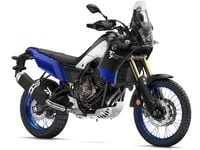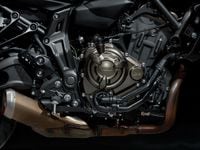A new kind of twin-cylinder motorcycle engine has emerged from the ocean of choice. Exemplified by the Yamaha MT-07, Kawasaki Ninja 650, and KTM 790, it is a tall but otherwise very compact liquid-cooled parallel twin with a balancer to neutralize vibration, a vertically stacked gearbox to make it very short front to back, and a power section inspired by 35 years of sportbike engine development.
These engines cut costs by being light and having low parts counts. V-twins have their appeal but require the luxury of two cylinder heads, two separate camshaft drives, and four cams to the parallel twin's one head, one drive, and two cams. Reliability comes from the proven engine architecture of placing oil sump and pump directly beneath the crankshaft, generously lubricating and cooling all-plain-bearing support of crankshaft, cams, and con-rods. These engines are self-reinforcing because their cylinders are cast in one piece with their upper crankcases. We also see that these twins are durable: Adapted for dirt-track racing, Kawasaki's Ninja 650 became a winner, especially in the power-hungry mile events. Recently, JD Beach won the American Flat Track Arizona Super TT on an MT-07-powered machine.
If required by the application, these twins can make real power for they are built as sportbike engines have come to be built. As we have learned, engine characteristics depend much more on cam timings and valve lift than they do on stroke, so making a stump-pulling twin is just a matter of shortening its cam timings and valve overlap. Bores and strokes of these new twins are oversquare—meaning bore is bigger than stroke—but not sportbike-ishly so.
Because these new twins are liquid-cooled, they can generate serious torque by use of high compression ratio, as in 12.5:1. Engines of earlier eras were air-cooled because that was considered simple and weight-saving, but they ran hot, limiting compression to about 9:1. That seriously reduced their torque. In the context of today’s emissions and noise limits, air-cooling is not only more complex to clean up, it is heavy. The mass of fins is solid metal, growing out of a “cylinder cap” often 3/4 of an inch thick necessary to store heat during bursts of full throttle. Circulating water cools more intensively than solid metal and fins.
Why this, why now? These engines are the considered response of the motorcycle industry to the Great Recession of 2008, which triggered a 60 percent shrinkage of new-bike sales. Even today in the US, sales of used bikes outnumber new by about four to one. After some oddball initial offerings followed by a flock of low-priced 300cc-class bikes, industry planners saw that price is not the whole story. People do need lower prices, but they want to move with traffic, sometimes with a passenger. That requires engines with more grunt. These larger new twins provide that.
It is only good sense today to make one basic engine power a variety of machines in a variety of roles. This requires versatility, and these compact new twins deliver it by being light and capable.
I traced the origins of MT-07 into the past. Its immediate predecessor was the TDM series of liquid-cooled five-valve DOHC twins, beginning with the Mk 1 of 1992. This 850 was conventional in having a 360-degree crankshaft. Dual balancer shafts added bulk and weight. Why five valves? That was what Yamaha was doing at the time.
The Mk II appeared in 1996, still with five valves but now with a 270-degree “crossplane” crankshaft like that of MT-07 today. In 2001–’02, its place was taken by TDM900, still five-valve and 270 crank, but now with six speeds. Gearbox shafts were vertically stacked but the presence of the rear balance shaft added length and bulk.
We can see that MT-07 is a refinement of the TDM concept because its single front-mounted balance shaft, vertically stacked gearbox shafts, and YZR-M1-derived (Yamaha’s MotoGP engine) four-valve head result in a smaller, tighter, and lighter package that can fit into more kinds of bikes.
Its predecessor was the XTZ750 Super Ténéré, also a twin with five-valve head, twin balancers, and successful in Paris-Dakar. That 750 twin arose from the XTZ660, a single with one balance shaft and five-valve head. Unlike later Yamaha dual-sport engines, which like MT-07 turn on durable plain bearings, the 660 retained a two-stroke-like pressed-together roller crank. Roller cranks simplify the oiling system because they need very little but can’t deliver modern durability, except in motocross, where the need for lightest possible weight dictates stark simplicity.
From that 660, we trace back to 1975 and the venerable single-cylinder XT500, which won Paris-Abidjan and then Paris-Dakar in the later 1970s. It was even simpler, with just two valves, air-cooling (high cylinder-head temperature limited compression ratio to 9:1), five transmission speeds, and a roller crank (like those still found to this day in lightweight four-stroke motocrossers). This is a long engine because its gearbox shafts are one ahead of the other in 1970s style, and there is no balance shaft. XTs became four-valve 600s in 1982.
Why did Japanese makers begin building 500cc four-stroke singles in the 1970s? Several prominent veteran riders, former Cycle World staffer Jody Nicholas among them, mounted a vigorous campaign to bring back the big singles (such as BSA's versatile Gold Star) in some form. Kawasaki's 1972 project was code-named "Lobster," and Yamaha's was the XT.
The first Japanese imports were road bikes—Hodaka was the big exception—so how did the dual-purpose idea arise? Bultaco, whose very light two-stroke Sherpa-T blew four-strokes right out of trials competition in 1965, successfully promoted its high-performing off-road two-strokes in the US. This showed Yamaha the potential of the off-road or dual-purpose market. Its first try was the DT series of single-cylinder dual-purpose bikes, built in many displacements from 1968, developed, and refined. When, in the early 1970s, the EPA made it clear that simple two-strokes had no future on US highways, development of dual-purpose four-strokes was essential.
This history shows vibrating and elemental singles becoming smoother twins, and engine durability and power being boosted by adoption of sportbike technologies such as four valves, fuel injection, liquid-cooling, and long-lasting plain bearings. The resulting engines deliver the versatility to power bikes in many categories, on- or off-road.













/cloudfront-us-east-1.images.arcpublishing.com/octane/JJ3MC6GNDFF5ZNYD3KD3E4EY7Y.jpg)
/cloudfront-us-east-1.images.arcpublishing.com/octane/XH2ETEU4NVGDFNQO2XT2QQS5LU.jpg)
/cloudfront-us-east-1.images.arcpublishing.com/octane/UFG652C27BDBFPK42TDAJ5CMX4.jpg)
/cloudfront-us-east-1.images.arcpublishing.com/octane/AUE3NFVRRZDSBIDVUGIYIDQNUI.jpg)
/cloudfront-us-east-1.images.arcpublishing.com/octane/LYR62CH2WNBMHJJVXVATZHOUE4.jpg)
/cloudfront-us-east-1.images.arcpublishing.com/octane/RBCTRGBQYBDK7A6XPG3HKPS7ZQ.jpg)
/cloudfront-us-east-1.images.arcpublishing.com/octane/MQXQRYMZVBCWJIRYP3HEN3SHVE.jpg)
/cloudfront-us-east-1.images.arcpublishing.com/octane/TSPODNNEWRDSVJGUCNQTDG4ADI.jpg)
/cloudfront-us-east-1.images.arcpublishing.com/octane/X5TB7BDV4BA2RPSY54ZGK27RP4.jpg)
/cloudfront-us-east-1.images.arcpublishing.com/octane/REUHOJXRDBGZ5IHBYZCCBCISPA.jpg)
/cloudfront-us-east-1.images.arcpublishing.com/octane/52LGJTCKBFEHDF7S7H4CVUIMGM.jpg)
/cloudfront-us-east-1.images.arcpublishing.com/octane/YMWAIPIPSJAOXOU3QMJMGH37OM.jpg)


/cloudfront-us-east-1.images.arcpublishing.com/octane/EJ6KZRGAYBCVXNL2PJXL37UVWQ.jpg)
/cloudfront-us-east-1.images.arcpublishing.com/octane/AAN4TI76M5H5JMUVEIGASWXBDU.jpg)
/cloudfront-us-east-1.images.arcpublishing.com/octane/P3RXD2UCPFF37CMB7CHPVKXORY.jpg)
/cloudfront-us-east-1.images.arcpublishing.com/octane/VZEG2EJI2RDFZNHLRZMU56MD3Q.jpg)
/cloudfront-us-east-1.images.arcpublishing.com/octane/GVJQO5FFOFBWNGODOBRB4FBAW4.jpg)
/cloudfront-us-east-1.images.arcpublishing.com/octane/BIVAK2SFIBDJJM25E7I5VU2FJE.jpg)
/cloudfront-us-east-1.images.arcpublishing.com/octane/CH5VX52UG5CFHOVH5A6UYEFWWA.jpg)
/cloudfront-us-east-1.images.arcpublishing.com/octane/ZVGJNGZRU5C33N7KN23BBFKSC4.jpg)

